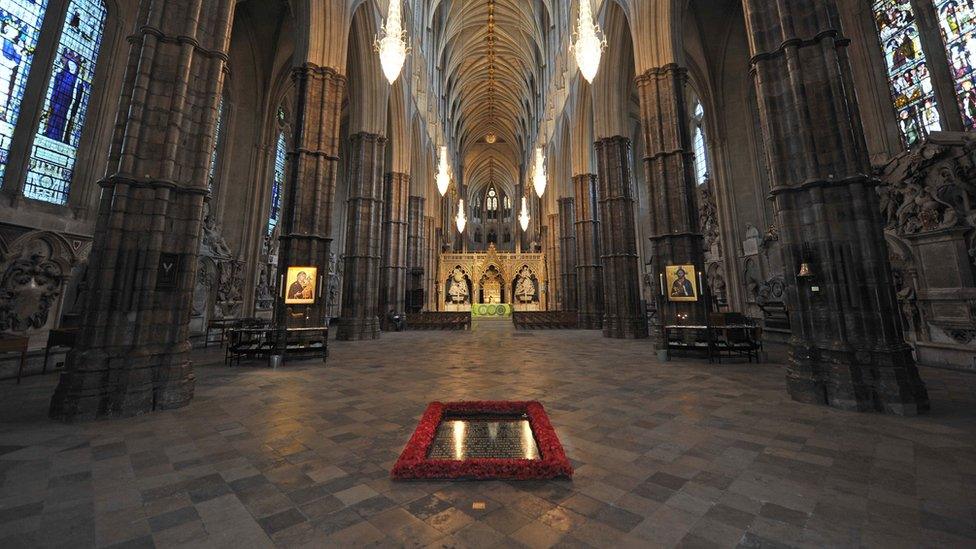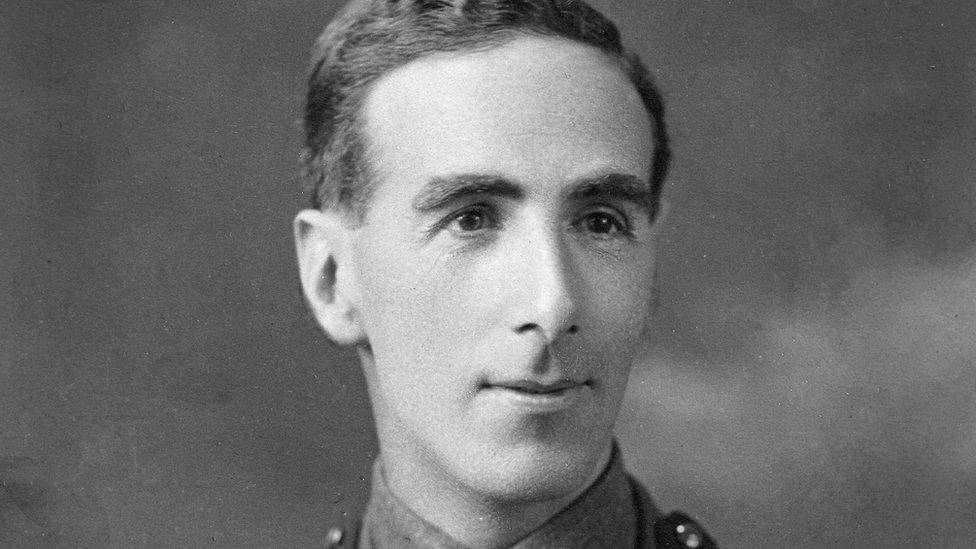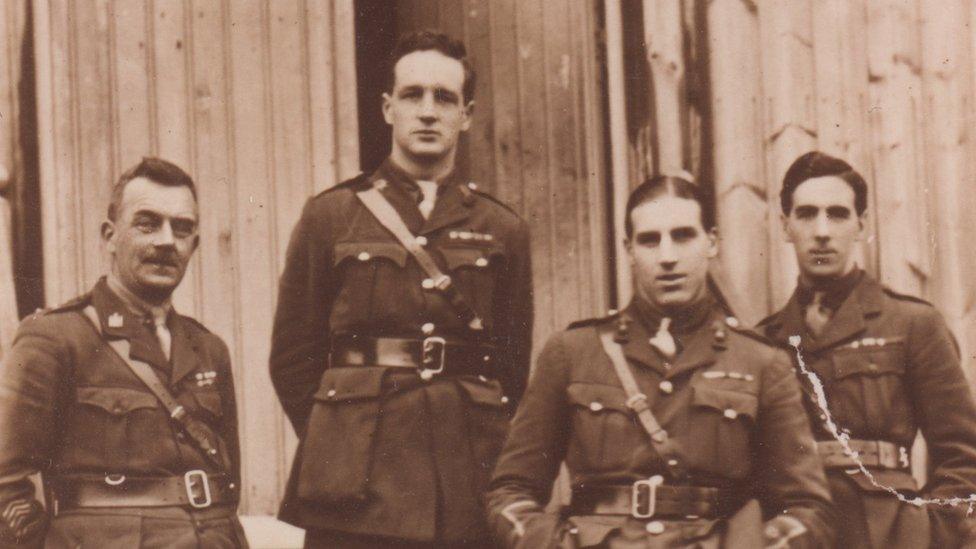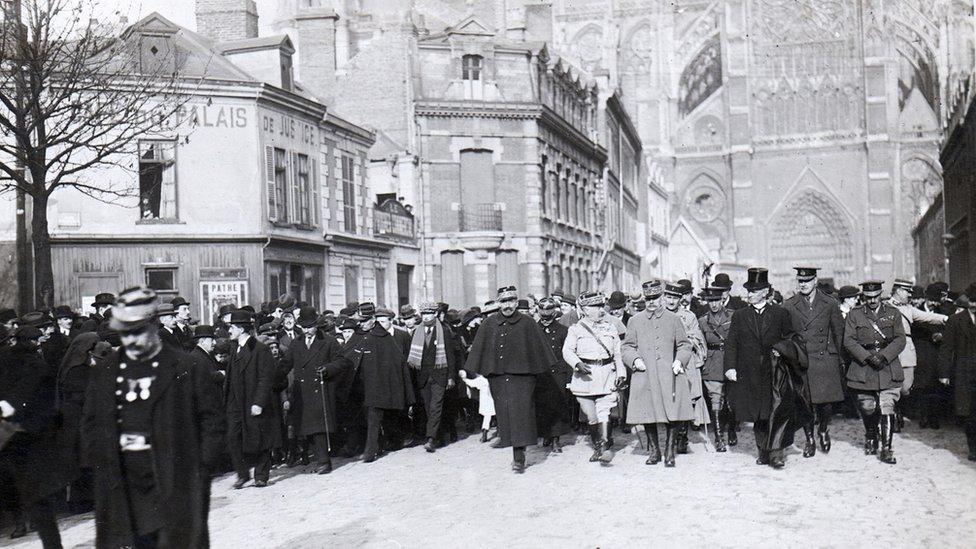Remembrance Sunday: NI family link to WWI unknown warrior
- Published

The tomb of the Unknown Warrior in Westminster Abbey
Remembrance Sunday is always an emotional day.
People placing wreaths at Cenotaphs around the UK, the music and former soldiers, some now very old, walking by wearing a poppy.
Then there's the two minute silence to mark the day World War One ended, at 11:00 on the 11th day of the 11th month, in 1918.
My great uncle, Maj Samuel Ernest Fitzsimon, or uncle Fitz as we called him, served in World War One.

Maj Ernest Fitzsimon MBE served with the 14th Royal Irish Rifles
I remember my great uncle Fitz as a tall, well built man with gold-rimmed glasses, who wore a grey tweed suit with a waistcoat, watch and chain, a big heavy Ulster overcoat and a hat.
He was my granny's brother and he came to our home in Bangor every November to attend the Cenotaph for Remembrance Sunday.
'The unknown warrior'
He had stayed on in France for two years after the war ended, retrieving bodies, identifying them where possible and laying them to rest in the war cemeteries in France.
He also played a pivotal role in bringing the body of the Unknown Warrior back from the battlefields of northern France.

Maj Fitzsimon (far right) was part of the team who repatriated the Unknown warrior and three other bodies in 1920
The idea of the unknown warrior was a serviceman to represent all the dead of the World War One, external, his identity never to be known.
My uncle had helped exhume four bodies of British servicemen from battlefields at Arras, Ypres, the Aisne and the Somme and then the transportation of one of the bodies to represent the Unknown Warrior.
The Unknown Warrior was laid to rest among kings and statesmen in Westminster Abbey and remains there to this day.
Uncle Fitz had been the executive officer and planned a large part of the unknown warrior operation. He was later made an MBE for his service to the Crown.
His connection to the unknown warrior was a family story that I've always known, but the there's another local connection that I've only recently become aware of.
The notebook
It started with a tiny notebook written by Comber man Mark Scott, and his quest to find out more about the names in the diary of his great grandfather, Sgt Jimmy Scott, who served with my uncle Fitz and his brother Jim Fitzsimon in World War One.
Mark Scott's research led him to me in Bangor.

Maj Fitzsimon as part of a delegation at Amiens Cathedral, France, in 1920
There's always someone in a family who is a hoarder and keeps memorabilia and in ours, it's me.
Inside a large cardboard box of army papers and photographs was a letter written to uncle Fitz from his brother Jim from 50 years ago.
Uncle Fitz had asked his brother for some of his memories of the war.
Jim replied: "It's hard to remember incidents after over 50 years have passed. It was just routine from day to day.
"Somebody killed or wounded like an Inniskilling Fusilier, when we were firing our football mortars, they were about the size of a football with a long metal stem, the stems when the bomb exploded flew all over the place.
"I don't think we were callous about things, but when Sgt Jimmy Scott had just returned from cleaning up after a mortar bombardment and we were having something to eat and talking about it, Jimmy Scott picked up a small piece of bread and said 'they were blown into pieces as small as this' and he popped it into his mouth."
When I read that letter over the phone to Mark Scott, a letter mentioning his great grandfather Jimmy Scott, he was stunned.
Mark had no idea of our family story, that in 1920, 100 years ago this Remembrance Sunday, my great uncle Fitz had played a major role in exhuming the Unknown Warrior.
This started years of research for Mark and he was also able to establish what happened to the three other bodies which were not chosen.
They were buried in unmarked graves and the intention is now to formally mark those graves and highlight the important part those young men played.
It gives those whose loved ones may not have been found and who did not have an official burial, a focus point, a cenotaph where they can remember and salute them every year on Remembrance Sunday.
For more on the unknown warrior story listen to BBC Radio Ulster's Steven Rainey programme on Sunday, 8 November from 11.00 GMT.
- Published11 November 2010